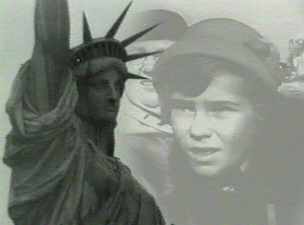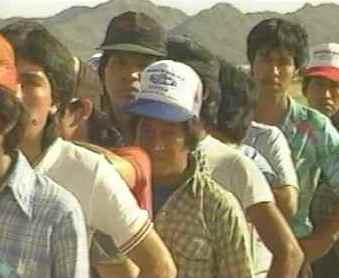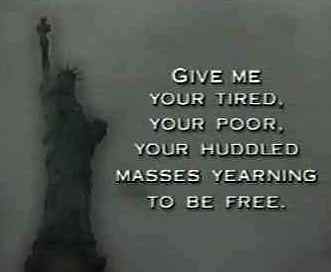
Promise and Hope for Generations.
| The Journal for MultiMediaHistory Volume 1 Number 1 ~ Fall 1998 |
Immigration: Promise and Hope for Generations. Princeton, NJ: Films for the Humanities and Sciences, 1997.
29 minute VHS video.
 |
Promise and Hope for Generations. |
After describing America as a nation of immigrants, the program attributes the growing anti-immigrant sentiment to the popular opinion that new immigrants are a burden to society. It cites a survey in Newsweek showing that half of those questioned believed immigrants "take jobs away from Americans, tax our school systems, and utilize public housing, welfare, and health care benefits."
In addition, the narration states that new immigrants are perceived as different from past immigrants. According to the program, native born Americans have an affinity with earlier immigrants: "Almost everyone of us has a story about relatives who came here off the boat with nothing but the American dream in their hearts and a few pennies in their pockets. But our ancestors worked hard. They assimilated into American culture, learning English and instilling a profound value, respect, and love for the United States in their children. . . . Those immigrants were our family, and they resembled us physically, spiritually and emotionally." As the previous passage suggests, many Americans notice new immigrants as physically and culturally different. They also believe these immigrants lack the values and commitment of previous immigrants.
 |
Promise and Hope for Generations. |
While sharing some of the economic benefits of immigration, the program includes comments on the cost of illegal immigration. Pete Wilson, the governor of California, claims that his state spends over $3 billion per year on health care, education, and incarceration for illegal immigrants. Dan Lundgren, the attorney general of California, blames the state's illegal immigrant crisis on inadequate enforcement of the 1986 Simpson-Mazzoli Act and makes a case for preventing illegal immigrants from receiving certain benefits. Wilson makes the following statement concerning immigration: "If we are going to seriously keep the front door open to legal immigration, which has so vitally enriched the United States generation after generation, we have to be equally firm in enforcing the laws that prohibit illegal immigration, because if you're letting people in the back door then the front door system doesn't work, it breaks down. And you create, you certainly risk creating, the kind of unfair animosity that should have now place anywhere in America." From the interview segments provided in the program, the audience walks away with the impression that Wilson and Lundgren only oppose illegal immigration and are actually advocates of legal immigration.
 |
of Liberty. From Immigration: Promise and Hope for Generations. |
One immigration advocate criticized the policies on humanitarian grounds. The new laws could affect asylum seekers since these refugees rarely had all the proper immigration documents. In addition, the removal of benefits would leave a segment of society uneducated and unhealthy since fear of deportation could lead illegal immigrants to avoid reporting crimes, seeking medical treatment, or sending children to school.
Unfortunately, the presentation of the immigration debate lacks clarity because Immigration addresses both legal and illegal immigration. Perhaps from confusion generated by the continual switching between the two sets of issues, I failed to realize whether a debate truly existed. None of those who were interviewed expressed opposition to legal immigration. The program tried to juxtapose the California politicians with Rudolph Guiliani, the mayor of New York City. However, all three favored legal immigration, and Guiliani never advocated illegal immigration. Moreover, Wilson and Lundgren never responded to the humanitarian arguments against the new welfare law or Proposition 187.
The content pertaining to illegal immigration needs additional explanation as well. At one point, Immigration relates that many people claim illegal immigrants depress the wages of non-skilled workers and support penalties for employers for knowingly hiring these immigrants. In the next scene, it points out that agriculture, computer, and engineering industries lobbied Congress not to place restrictions on the number of employment and education visas issued annually. Does this seamless transition mean that illegal immigration stems from the granting of work and education visas? If so, the program should provide statistical evidence for this phenomenon. It should also give an overview of administrative policy to answer questions regarding temporary visas and political asylum. To give one example, how does one decide when a Haitian refugee is emigrating for political rather than economic reasons?
 |
Immigration: Promise and Hope for Generations. |
Although it comments that many immigrants "no longer look like us," Immigration does not contain a serious discussion of race and ethnicity. This does not mean that these issues are absent. When commenting that almost half of the science and engineering graduate students in the United States are immigrants, the faces of three young Asians appear on the screen. Similarly, a Latino woman and three children can be seen walking while the following narration begins: "Many of us think today's immigrants come to America in hopes of living on easy street." Many questions can come to mind. Is this family living on welfare? Where is the father? Could these be illegal immigrants? Given the degree to which race and ethnicity influence public policy, the program's relative neglect of these issues is indefensible.
The conflation of illegal and legal immigration debates, the insufficient historical information, and the disregard of race and ethnic concerns detract from the video's overall utility as a classroom tool. A college audience could better spend the half hour directly addressing the issues.
Scott H. Tang
University of California at Berkeley
Video Review of Immigration: Promise and Hope for Generations
Copyright © 1998 by the Journal for MultiMedia
History.
![]() Comments
to: [email protected]
Comments
to: [email protected]
Contents: JMMH, Volume 1 Number 1 ~ Fall 1998